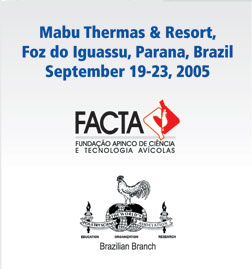Contributed Papers: Oral Presentations
Mixed Cocciodiosis Control: Drugs and Vaccines |
Restoration of
Field Eimeria Anticoccidial Sensitivity with Coccivac-B,
a Live Coccidiosis Vaccine
Greg F. Mathis,
Southern Poultry Research,
Inc. and C. Broussard, Schering-Plough Animal Health
Vaccination
was examined as an alternative strategy to rotation
of in-feed anticoccidials to maximize the sensitivity
of Eimeria spp. to anticoccidial compounds. The study
used anticoccidial sensitivity battery tests (AST’s)
to determine the baseline diclazuril sensitivity of
field Eimeria isolates from seven broiler complexes
that had recently used diclazuril. Based on weight
gain and lesion scores, 25% or fewer of the isolates
submitted by each complex demonstrated good sensitivity
to diclazuril. Following the baseline sampling, four
of the complexes rotated to non-diclazuril in-feed
anticoccidial programs and three of the complexes
rotated a Coccivac-B vaccination as the sole coccidiosis
control program for two broiler grow-out cycles. Eimeria
isolates were subsequently collected from the identical
houses on all seven complexes and diclazuril AST results
were compared to the baseline AST results. Following
the two grow-out cycles, sensitivity on the four complexes
that rotated to in-feed anticoccidials remained essentially
unchanged. The three complexes that rotated to Coccivac-B
vaccination demonstrated marked improvement in diclazuril
sensitivity, with good sensitivity in 60 to 100% of
the samples from each complex. Earlier examinations
of reversal of sensitivity using Coccivac-B used the
ionophore salinomycin as the baseline. Sensitivity
is easier to determine with a chemical anticoccidial
than an ionophorous anticoccidial. This study used
a chemical anticoccidial and clearly demonstrated
that vaccination with Coccivac-B has the potential
to replace resistant coccidia with sensitive coccidia.
